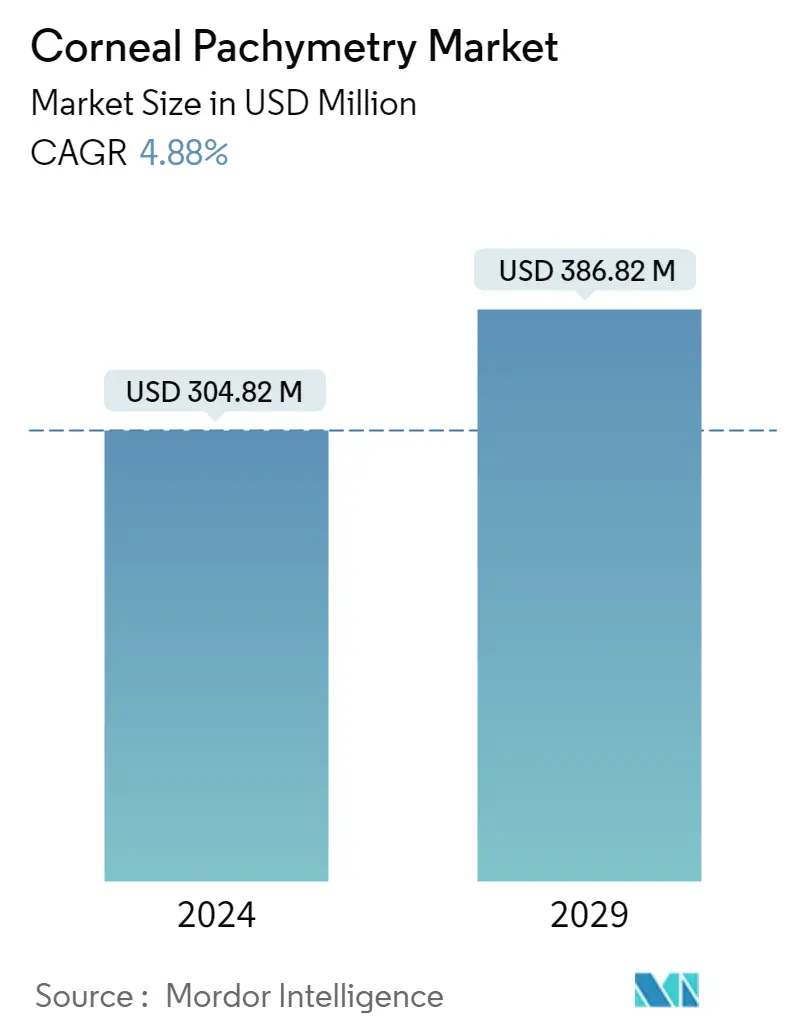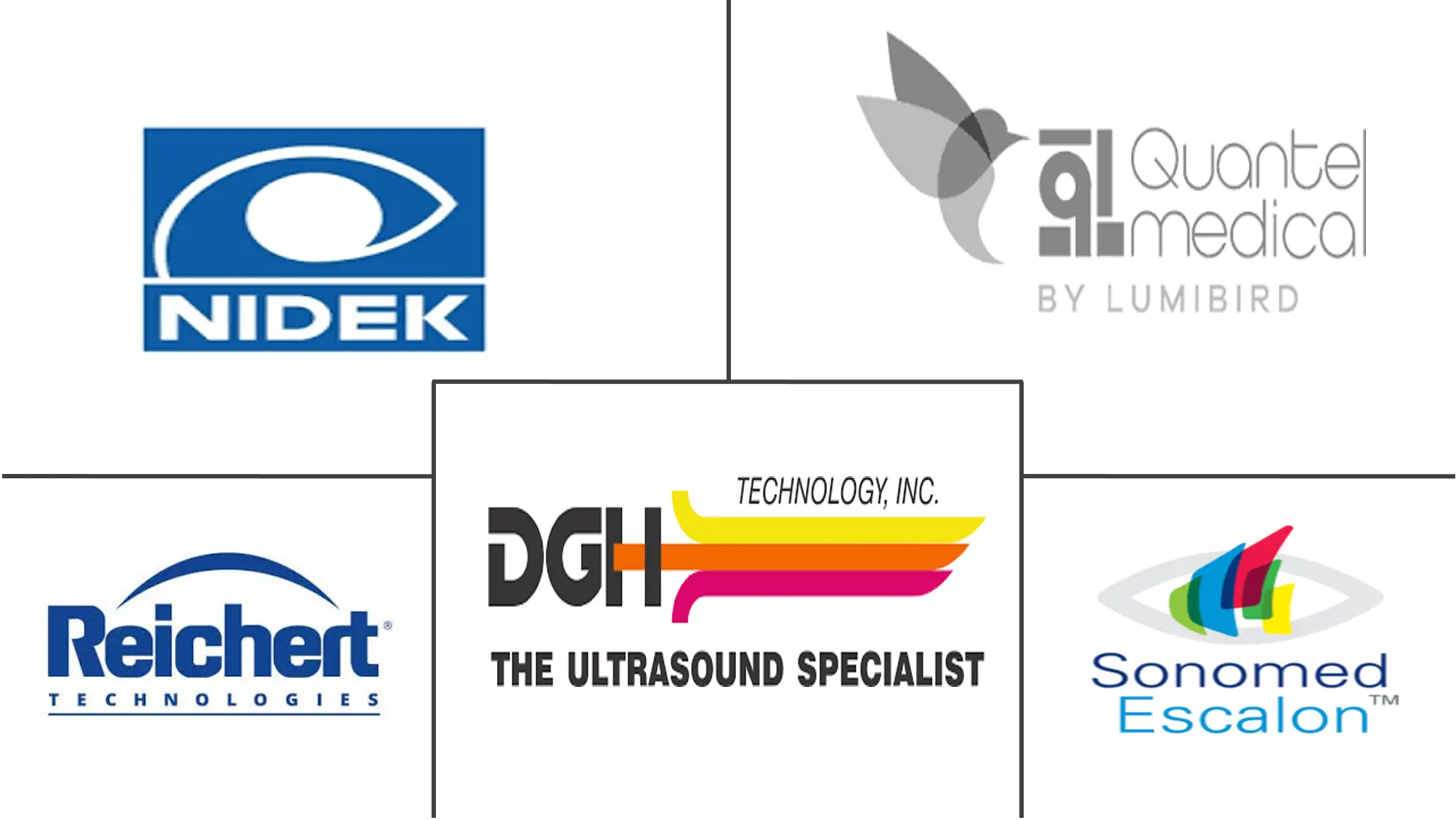Market Size of Corneal Pachymetry Industry

| Study Period | 2019 - 2029 |
| Market Size (2024) | USD 304.82 Million |
| Market Size (2029) | USD 386.82 Million |
| CAGR (2024 - 2029) | 4.88 % |
| Fastest Growing Market | Asia-Pacific |
| Largest Market | North America |
Major Players
*Disclaimer: Major Players sorted in no particular order |
Corneal Pachymetry Market Analysis
The Corneal Pachymetry Market size is estimated at USD 304.82 million in 2024, and is expected to reach USD 386.82 million by 2029, growing at a CAGR of 4.88% during the forecast period (2024-2029).
COVID-19 impacted the growth of the corneal pachymetry market. The pandemic resulted in a decline in eye procedures, which has impacted the demand for diagnostics and surgical equipment and thus slowed the market's growth during the pandemic. For instance, an article published in Clinical Ophthalmology in June 2022 stated that about 285 eye surgeries were performed in Germany during the pandemic period as compared to 12 during the pre-pandemic period. However, with resumed services and increased hospital visits, the demand for corneal transplantations and diagnostic procedures for eye-related diseases has increased. This is anticipated to fuel the growth of the market over the forecast period.
The market is growing because of things like the growing number of people with glaucoma and other eye problems and the growing number of people with diabetic retinopathy.For example, according to an article in Special Focus: Community Ophthalmology from June 2022, 28.8% of people in Shillong, India had refractive error (RE) in their worst eye.Also, the same source said that presbyopia, with or without distance vision, was the most common type of RE.So, the high number of refractory errors drives up the demand for refractive surgery, which is expected to fuel market growth over the next few years.
Also, as the number of people with diabetes rises, the risk of getting diabetic retinopathy will likely rise, which will increase the demand for effective treatments and help the market grow.For example, according to the IDF's 2022 statistics, about 537 million people around the world had diabetes in 2021, and this number is expected to rise to 643 million in 2030 and 784 million in 2045.So, the growth of the market over the next few years will be driven by the expected rise in the number of people with diabetes.
Also, more people are becoming aware of eye diseases like cataracts, glaucoma, dry eye disease, and others. This raises the demand for diagnostics and surgical procedures, which is expected to drive the growth of the market over the next few years.For example, an article in Healthcare from June 2021 says that between November 15, 2020, and January 15, 2021, a study was done to find out how much the general population of the Hail Region in Saudi Arabia knows about common eye problems and what might cause them.31% of the people who took part in the study knew about cataracts, 43% knew about glaucoma, 66% knew about dry eyes, and 44% knew about diabetic retinopathy.The same source also said that 46% of the participants knew about eye conditions, with male participants knowing more than female participants.
Moreover, rising company activities and increasing product launches are also contributing to market growth. For instance, in December 2021, Ophthalmic Sciences Ltd., an Israeli startup, launched a device, IO Perfect, that uses artificial intelligence to measure intraocular pressure in patients suffering from glaucoma. The device provides remote glaucoma monitoring by integrating artificial intelligence (AI) and visual analysis into a virtual reality headset. The device can be utilized at home, in eye clinics, emergency rooms, pharmacies, and in settings with primary care doctors.
Because of things like the growing number of people with diabetes and the growing number of people with refractory errors and other eye diseases, the studied market is expected to grow over the next few years. However, the inadequate reimbursement coverage for pachymetry and stringent government regulations are likely to impede the growth of the corneal pachymetry market over the forecast period.
Corneal Pachymetry Industry Segmentation
As per the scope of the report, a pachymeter is a medical device used to measure corneal thickness. It is also used to determine endothelial pump and corneal barrier functions. Moreover, it helps in determining intraocular pressure in the case of glaucoma. Corneal thickness greater than 640 m increases the risk of corneal decompensation. Ultrasound and optical pachymeters are the two devices used to perform pachymetry. The Corneal Pachymetry Market is Segmented by Type (Ultrasonic Method and Optical Method), Application (Glaucoma Diagnosis and Refractive Surgery), and Geography (North America, Europe, Asia-Pacific, the Middle East and Africa, and South America). The market report also covers the estimated market sizes and trends for 17 countries across major global regions. The report offers the market size and forecasts in value (USD million) for the above segments.
| By Type | |
| Ultrasonic Method | |
| Optical Method |
| By Application | |
| Refractive Surgery | |
| Glaucoma Diagnostics |
| Geography | ||||||||
| ||||||||
| ||||||||
| ||||||||
| ||||||||
|
Corneal Pachymetry Market Size Summary
The corneal pachymetry market is poised for growth over the forecast period, driven by an increasing prevalence of eye conditions such as glaucoma, diabetic retinopathy, and refractive errors. The market's expansion is supported by the rising number of individuals with diabetes, which is expected to elevate the demand for effective diagnostic and treatment options. The resurgence of eye procedures post-COVID-19 has further bolstered market growth, as the demand for corneal transplantations and diagnostic procedures has increased. Additionally, heightened awareness of eye diseases and advancements in diagnostic technologies, such as the integration of artificial intelligence in glaucoma monitoring, are contributing to the market's positive trajectory. However, challenges such as inadequate reimbursement coverage and stringent regulatory environments may impede growth.
North America is anticipated to experience significant market growth due to the high prevalence of diabetes-related complications and an aging population. The region's established healthcare infrastructure and increasing company initiatives to raise awareness about glaucoma and other eye conditions are expected to drive demand for corneal pachymetry. The market is characterized by a high degree of fragmentation, with numerous players engaging in strategic activities like product launches, mergers, and acquisitions to enhance their market presence. Key players include NIDEK Co. Ltd., Quantel Medical, Sonomed Escalon, and others, who are actively involved in developing innovative solutions to meet the growing demand for eye care diagnostics and treatments.
Corneal Pachymetry Market Size - Table of Contents
-
1. MARKET DYNAMICS
-
1.1 Market Overview
-
1.2 Market Drivers
-
1.2.1 Rise in Prevalence of Glaucoma and Eye-related Disorders
-
1.2.2 Rise in Prevalence of Diabetic Retinopathy
-
-
1.3 Market Restraints
-
1.3.1 Inadequate Reimbursement Coverage for Pachymetry
-
1.3.2 Stringent Government Regulations
-
-
1.4 Porter's Five Forces Analysis
-
1.4.1 Threat of New Entrants
-
1.4.2 Bargaining Power of Buyers/Consumers
-
1.4.3 Bargaining Power of Suppliers
-
1.4.4 Threat of Substitute Products
-
1.4.5 Intensity of Competitive Rivalry
-
-
-
2. MARKET SEGMENTATION (Market Size by Value - USD million)
-
2.1 By Type
-
2.1.1 Ultrasonic Method
-
2.1.2 Optical Method
-
-
2.2 By Application
-
2.2.1 Refractive Surgery
-
2.2.2 Glaucoma Diagnostics
-
-
2.3 Geography
-
2.3.1 North America
-
2.3.1.1 United States
-
2.3.1.2 Canada
-
2.3.1.3 Mexico
-
-
2.3.2 Europe
-
2.3.2.1 Germany
-
2.3.2.2 United Kingdom
-
2.3.2.3 France
-
2.3.2.4 Italy
-
2.3.2.5 Spain
-
2.3.2.6 Rest of Europe
-
-
2.3.3 Asia-Pacific
-
2.3.3.1 China
-
2.3.3.2 Japan
-
2.3.3.3 India
-
2.3.3.4 Australia
-
2.3.3.5 South Korea
-
2.3.3.6 Rest of Asia-Pacific
-
-
2.3.4 Middle East and Africa
-
2.3.4.1 GCC
-
2.3.4.2 South Africa
-
2.3.4.3 Rest of Middle East and Africa
-
-
2.3.5 South America
-
2.3.5.1 Brazil
-
2.3.5.2 Argentina
-
2.3.5.3 Rest of South America
-
-
-
Corneal Pachymetry Market Size FAQs
How big is the Corneal Pachymetry Market?
The Corneal Pachymetry Market size is expected to reach USD 304.82 million in 2024 and grow at a CAGR of 4.88% to reach USD 386.82 million by 2029.
What is the current Corneal Pachymetry Market size?
In 2024, the Corneal Pachymetry Market size is expected to reach USD 304.82 million.

